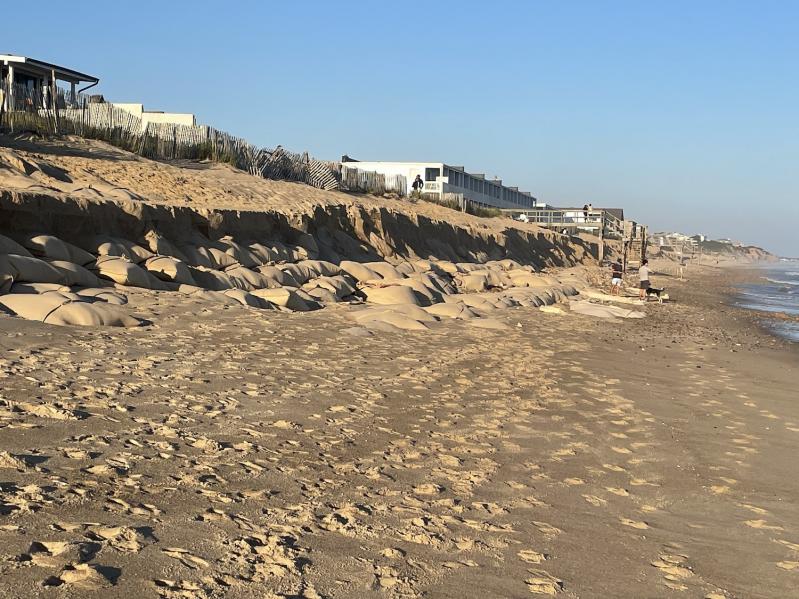The long-awaited Fire Island to Montauk Point reformulation project, a coastal restoration and protection effort covering 83 miles of shoreline between Fire Island and Montauk Point, is set to begin this fall, with downtown Montauk to see the bolstering of its Atlantic Ocean beach with 450,000 cubic yards of sand dredged and pumped from an offshore site on Napeague during the winter or early spring.
The federal Army Corps of Engineers has selected Great Lakes Dredge and Dock Company to conduct the beach restoration and refurbishment at the downtown Montauk ocean beach. That work is to immediately follow a Fire Island-Moriches Inlet beach restoration, scheduled to begin this fall.
The work at Fire Island is expected to take several months. The Army Corps is to calculate an estimated start date for the work in Montauk based on the timing and progress made at Fire Island. The sand-only beach refurbishment is intended to create a wider, more resilient beach. The downtown Montauk component of the project is expected to take several months, but is anticipated to be completed prior to the 2024 summer season.
Using a “hopper dredge,” Great Lakes Dredge and Dock Company will dredge and pump beach-compatible sand from an offshore “borrow site” off Napeague and place it on a length of beach between the Benson Reservation on the west to just east of Surfside Place. The additional sand will extend the beach area both above and below sea level. It is intended to create a wider beach that is more resistant to future erosion and storms. “It’s going to be a gradual slope so it won’t be as susceptible to wave action,” Councilwoman Kathee Burke-Gonzalez, who is running for supervisor, said during a candidates’ forum in Montauk on Sunday.
Public access to the beach is to be maintained during the beach restoration process, though active work areas will be off limits to the public. The contractor will use the town parking lot at Kirk Park as a staging area. The town will post information on its website with periodic updates through press releases and social media.
After completion of the work in Montauk, periodic beach renourishment with 400,000 to 450,000 cubic yards of sand is expected to take place every four years, for the next 30 years. The cost of that work will be jointly borne by the Army Corps, New York State, and the local municipalities.
The town board voted last year to adopt the Coastal Assessment Resiliency Plan, or CARP, into the town’s comprehensive plan. The plan was created in recognition of the need for proactive planning to address vulnerabilities to sea level rise, shoreline erosion, and flooding, and notes that the currently projected range of sea level rise “will transform East Hampton into a series of islands with permanent submergence of low-lying areas as early as 2070,” with other long-term effects of climate change increasing the town’s vulnerability to coastal flooding and shoreline erosion.
“We’re very pleased to be at this point,” a jubilant Supervisor Peter Van Scoyoc said of word of the impending implementation of the Fire Island to Montauk Point reformulation project, called FIMP for short, “and hopefully it will give us enough breathing room to be able to implement some of our longerterm strategies for coastal adaptation.”
“The downtown beach replenishment is the latest and intermediate step in the town’s overall coastal strategy, on which I worked for the entirety of my 12-year tenure,” he said. “This is an important milestone in the implementation of our coastal policy, and hopefully will provide enough protection to complete the long-term resilience goals, sustaining Montauk’s vital economic contributions and recreational attributes.”
In a statement on Tuesday, David Freudenthal, chairman of Concerned Citizens of Montauk, said that C.C.O.M. “has been working with East Hampton Town since 2013 to develop a comprehensive long-term solution for Montauk’s coastline, including development and adoption in 2022 of the Coastal Assessment and Resiliency Plan. Having fought for this outcome we are thrilled by today’s announcement and the 30-year Montauk downtown coastal stabilization it will bring. Although not a long-term solution to protecting our beaches, dunes, and community, it is a critical medium-term step to allow all stakeholders time to develop a more comprehensive response plan as utlined in CARP and by C.C.O.M.”
More than 60 years in the making — “this is a project that was begun when I was 1 year old,” Mr. Van Scoyoc said — the Army Corps began consideration of a comprehensive and long-term Fire Island to Montauk Point protection plan for areas prone to flooding, erosion, and other storm damage in the 1950s. The impacts of Superstorm Sandy, in 2012, precipitated emergency measures that were undertaken in advance of the FIMP project. The Army Corps completed the controversial downtown Montauk stabilization project in 2016, which saw reinforcement of approximately 3,100 feet of ocean beach with sand-filled geotextile bags after Sandy caused significant erosion. Since then, according to an agreement with the Army Corps and New York State Department of Environmental Conservation, the town and Suffolk County have shared the cost of replenishing the sand covering the bags every year.
A full replenishment of the Montauk beach was not initially included in the FIMP project plan, but town officials, led by then-Supervisor Larry Cantwell, negotiated its inclusion, with support from regional and congressional elected officials.




